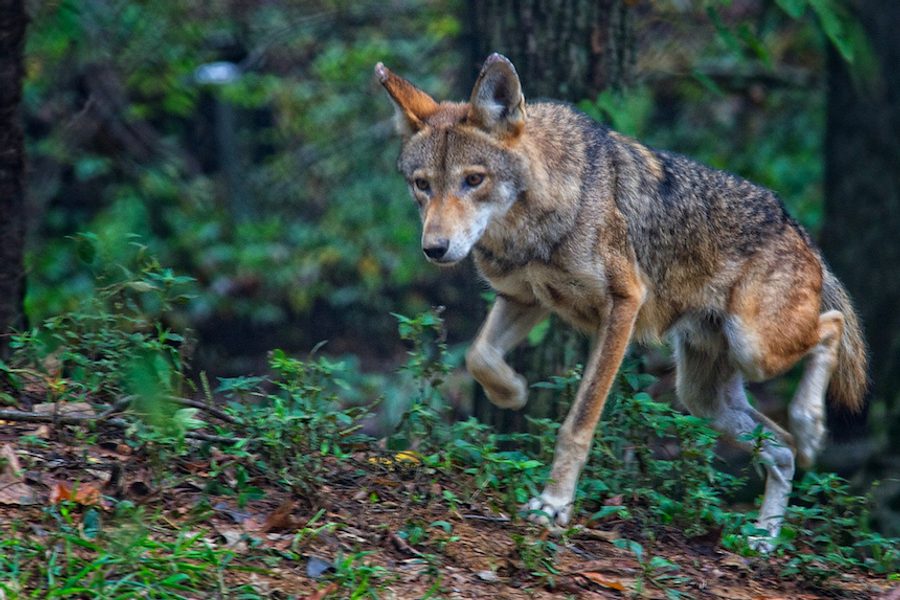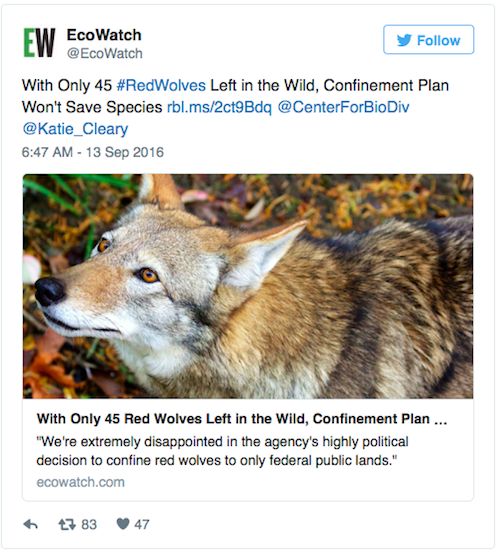Federal Species Survival Plan Threatens Existence of Wild Red Wolf Population
Dan Zukowski

The same scientists who provided the population viability analysis to the U.S. Fish and Wildlife Service (USFWS) for the red wolf have sent a rebuttal to the agency, accusing it of “many alarming misinterpretations” in its justification for removing most of the remaining animals in the wild.
Last month, the USFWS announced that it would recapture 32 of the 45 wolves in the wild and leave only those on federal lands. Currently, there are about 200 red wolves in captive breeding programs in the U.S. as part of the agency’s Species Survival Plan (SSP).

(Image: Screen Grab)
The letter, released to the public today, bluntly counters the agency’s proposal to recapture 32 wolves and place them in captive breeding programs:
“A singular focus on the SSP will no doubt result in extinction of red wolves in the wild.”
On Sept. 29, the U.S. District Court for the Eastern District of North Carolina issued a preliminary injunction ordering the USFWS to stop capturing and killing — and authorizing private landowners to capture and kill — members of the rapidly dwindling population of wild red wolves.
“There’s no need to capture wild wolves in an effort to save the captive population, which is what the service contends,” said Defenders of Wildlife attorney Jason Rylander.
In their letter, the three scientists, from Lincoln Park Zoo, Point Defiance Zoo and Aquarium and the AZA Population Management Center, dispute the agency’s contention that the captive breeding program needs more wild red wolves for greater genetic diversity.
“The scientists’ letter makes clear that the U.S. Fish and Wildlife Service’s proposal to withdraw red wolves from most of their range in North Carolina has no scientific basis and confirms that the agency’s conclusion that the captive population is at risk is wrong,” said Jamie Rappaport Clark, president and CEO of Defenders of Wildlife.

(Image: Screen Grab)
A poll of North Carolina voters and the state legislature have shown strong support for the efforts to restore the red wolves to their native habitat. For now, the injunction remains in effect. No court date has been set for a hearing and it is not expected until sometime in 2017.
The letter asks the agency to “edit or append” its decision memo. “This letter confirms what red wolf advocates have been saying all along: capturing wild red wolves and placing them into captivity isn’t the answer. The U.S. Fish and Wildlife Service needs to recommit to red wolf recovery in the wild,” Clark said.

I hope you found this article important. Before you leave, I want to ask you to consider supporting our work with a donation. In These Times needs readers like you to help sustain our mission. We don’t depend on—or want—corporate advertising or deep-pocketed billionaires to fund our journalism. We’re supported by you, the reader, so we can focus on covering the issues that matter most to the progressive movement without fear or compromise.
Our work isn’t hidden behind a paywall because of people like you who support our journalism. We want to keep it that way. If you value the work we do and the movements we cover, please consider donating to In These Times.



